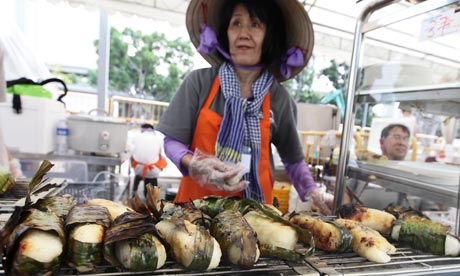Street food in Singapore is not actually on the streets – traders operate from designated 'hawker centres'. Would this model work in Britain?

Vietnamese chuoi nuong at the World Street Food Congress in Singapore. Photograph: Suhaimi Abdullah/Getty Images
If there is one thing I take from the works of Anthony Bourdain, it's that you only live once – so eat out of your comfort zone. If you're in the Philippines and want to try a slab of congealed pig's blood, head for the street markets. And if you want to try balut – incubated duck eggs complete with embryo – it's the streets where you'll get lucky. If "lucky" is the word … That's why Bourdain was invited to speak at last week'sWorld Street Food Congress in Singapore. There's just one problem – Singapore doesn't have street food.
Singapore took street food off its streets 20 years ago. Because of health and safety concerns, the traders (or hawkers) were moved towarehouses with electricity and running water. And now, if you want wee nam kee – poached chicken on top of rice glistening with chicken fat – you'll have to visit one of the country's 107 "hawker centres". Odd, then, for Singapore to host a congress of world street food, and to invite a man who is all about life off the beaten track to make the keynote address.
Bourdain took the opportunity to bemoan the state of fine dining in London, New York or Paris, where he said the food was unlikely to have a sense of place. "But on the streets of Mexico," he said, "you know where you are." He raved about pho on the streets of Vietnam, and how it tasted better on a low plastic stool amid the durian and diesel fumes. But he didn't rubbish the hawker centres. Even a food hedonist like Bourdain can see that they have a lot to recommend them.
The 107 centres – with 10 more planned in the next five years – are similar to western food courts, lined with avenues of uniform little boxes serving food. In the middle are plastic tables and wipe-clean seating. Each stall is given a government cleanliness rating, which is displayed at eye level – the difference between an A and a B can be a month's salary. All of the food is good. Some of it is great. But something is missing – the individuality that we prize so highly in British street food.
To see the lunchtime queues at Maxwell Road, a hawker centre in Singapore's central business district, you wonder if that really matters. Business types queue for their chilli crab or fish-head curry next to schoolchildren and taxi drivers – street food in Singapore seems democratic in a way that British traders can only dream of. It's not just for the cool kids. Is this the way forward for Britain? Should we copy the model that has being adopted in Singapore, Malaysia and Hong Kong?
The Nationwide Caterers Association – the trade association for street food catering in Britain – is ambivalent. "Traders in this country find it so hard to get permission to trade anywhere, I'm sure many would jump at the chance to trade from a subsidised food court," says Mark Laurie, the director of NCASS. "But they would miss the opportunity to express themselves on the streets. Street food is about quality, affordable food, and choice – our traders just want the chance to offer that."

No comments:
Post a Comment